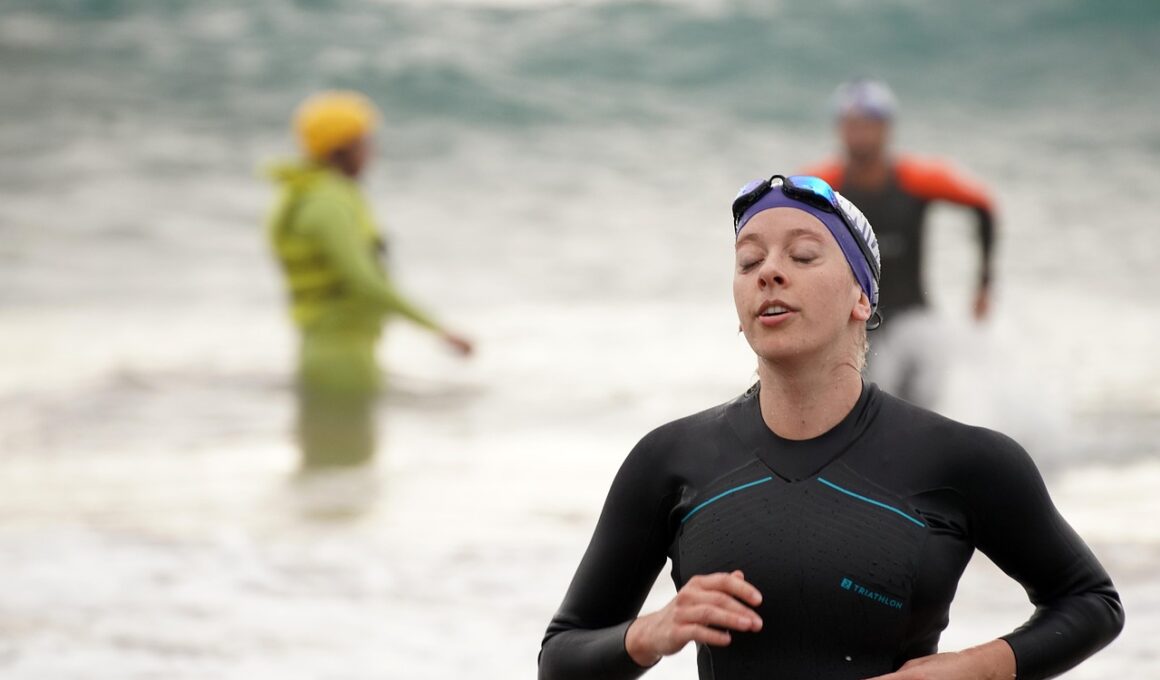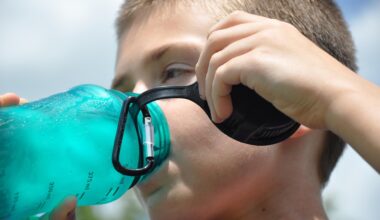How to Avoid Overtraining with Strength Workouts in Triathlon
Triathletes often focus on endurance training, but strength workouts play a crucial role in performance. To maximize effectiveness and prevent overtraining, a structured approach to strength training is essential. Understanding how strength training complements triathlon training can lead to better performance and lower injury risks. Balancing strength workouts with your triathlon routine involves several elements: prioritizing quality over quantity, incorporating functional exercises, and adhering to a well-structured program. This comprehensive strategy ensures triathletes develop the necessary muscle strength to support endurance, enhance race performance, and minimize fatigue. Furthermore, integrating adequate rest periods facilitates muscle recovery and growth. This leads to increased strength without the risks associated with overtraining. It’s vital to listen to your body; if you experience persistent fatigue or soreness, it may signal overtraining. Recovery strategies like proper nutrition, hydration, and sleep can mitigate these risks. Additionally, practicing mindfulness and maintaining a well-rounded training schedule can contribute significantly to overall well-being. Combining these elements creates a more sustainable training routine, ultimately enhancing performance and reducing the likelihood of burnout.
Implementing strength training into your triathlon routine requires understanding the key components of effective workouts. Focusing on compound exercises is essential for maximizing muscle engagement and aligning with triathlon-specific movements. Exercises like squats, deadlifts, and bench presses facilitate not just strength gains but also muscular endurance necessary for triathletes. These exercises enhance performance across swimming, biking, and running disciplines. Additionally, incorporating core training into your regimen is crucial for stabilizing your body during lengthy endurance events. A solid core improves posture and efficiency in each triathlon segment. As you plan your strength training, consider setting specific goals that align with your triathlon objectives, such as improving personal bests in races or developing greater overall strength. It’s also important to vary your workouts to prevent plateaus, including different variations of exercises such as kettlebell swings or resistance band workouts. Consistency remains vital but achieving goals also hinges on the quality of your sessions, not just frequency. Remember to track your progress over time to gauge improvements effectively. This analysis will help fine-tune your training approach, ensuring it remains both effective and enjoyable.
Signs of Overtraining and Recovery Strategies
It’s important for triathletes to recognize the signs of overtraining, which can negatively impact performance. Common symptoms include decreased performance levels, persistent fatigue, and increased irritability or mood swings. Paying close attention to these signs can prevent further complications. Notably, your body also communicates through physical aches and pains that could indicate overexertion. When these symptoms arise, implementing recovery strategies becomes imperative. Begin with active recovery techniques, such as gentle swims, cycling, or yoga, which promote blood flow and muscular relaxation while minimizing stress on the body. Prioritizing sleep is equally crucial as this allows your muscles to recover and rebuild efficiently. Nutrition also plays a vital role; consuming a diet rich in proteins, healthy fats, and complex carbohydrates aids in muscle regeneration and energy replenishment. Hydration, often overlooked, is essential for optimal recovery and overall performance. During recovery phases, consider cross-training options to engage different muscle groups without straining your primary disciplines. Most importantly, ensure you listen to your body and allow sufficient time for recovery. Every individual’s needs vary, and adapting your plan can lead to successful training outcomes.
To sustain balance between strength training and endurance workouts, athletes can explore various training techniques. One effective method is periodization, which involves organizing training into cycles with varying intensity and volume. This approach allows triathletes to peak during race season while providing ample recovery time throughout the year. Additionally, employing circuit training can be effective as it combines strength and endurance elements. This method keeps heart rates elevated while building strength, thereby improving overall fitness. Employing resistance bands and bodyweight movements can prevent the risk of injury, offering scalable challenges adaptable to individual fitness levels. Integrating strength workouts within the triathlon schedule often maximizes the benefits without overwhelming the athlete. Prioritize planning your weekly routine to accommodate these sessions effectively. It is key to ensure strength workouts are spaced adequately to allow muscle recovery prior to endurance training sessions. Strength workouts can complement swim, bike, and run days, focusing on timing for optimal efficacy. By shifting focus to specific muscle groups each session, you maintain a balanced approach while reducing overtraining risks. Consistent adaptation and reflection on your workouts will lead to continual progress in your triathlon performance.
Utilizing Technology for Performance Tracking
In this digital age, triathletes can utilize technology to enhance their training while preventing overtraining. Wearable devices, like heart rate monitors and fitness trackers, provide valuable insights regarding heart rates, caloric burn, and recovery times. Monitoring these metrics helps triathletes gauge workout intensity while ensuring recovery goals are met. Furthermore, various mobile applications can assist in designing strength training workouts tailored to triathlon needs. By setting individualized goals and using feedback from these digital tools, athletes can create balanced training plans. These tools also allow for tracking progress over time, fostering motivation and commitment to your regimen. Additionally, participating in online forums and social media groups can offer community support and shared experiences among fellow athletes. Interacting with others navigating similar challenges fosters camaraderie, pushing you to stay engaged with your training. As technology advances, integrating online coaching and virtual training platforms can also enhance your understanding of effective strength workouts tailored for triathletes. Communities and trainers can provide feedback, helping you refine techniques and avoid overtraining more effectively. Embracing these technologies can turn data into insights, promoting a smarter training execution strategy.
Recovery is a multi-faceted process that every triathlete should prioritize to counterbalance rigorous training. One of the most effective practices is the use of foam rollers, which aid in self-myofascial release. This technique reduces muscle tension and enhances recovery after strenuous workouts. Additionally, implementing stretching exercises post-workout not only alleviates soreness but also improves flexibility, allowing for optimized movement patterns during performance. Consider incorporating active recovery days into your weekly schedule as a way to rejuvenate. Engaging in light exercises like leisurely biking, walking, or swimming can prevent stiffness while promoting fresh blood flow to healing muscles. Massage therapy is another valuable tool in your recovery arsenal. Regular sessions can significantly enhance your overall performance and mitigate muscular discomfort. Prioritizing adequate hydration and nutrient intake forms the backbone of energy replenishment processes. Consistently fueling your body with the right vitamins, minerals, and hydration keeps performance levels high. Lastly, don’t underestimate the importance of mental recovery. Engaging in mindfulness practices helps maintain overall well-being while reducing stress. Balancing these strategies ensures that triathletes are always prepared, strong, and ready to tackle challenges while minimizing injury risks.
Conclusion: The Perfect Harmony of Strength and Endurance
In conclusion, achieving balance between strength training and endurance workouts is fundamental for triathletes. Prioritizing structured strength sessions enhances resilience, prepares athletes for challenges, and reduces the risks associated with overtraining. It’s essential to embrace a holistic approach by incorporating rest, monitoring performance indicators, and integrating recovery techniques. This combination not only fosters sustainable growth but also leads to improvement in overall performance. Crafting a training routine that highlights strength, endurance, and adequate recovery creates a well-rounded preparedness for upcoming races. Additionally, leveraging technology and community support provides further motivation and accountability throughout your journey. As you progress, remain adaptable to the changes your body communicates. Every triathlete will have unique experiences along the way, and learning from these helps refine long-term strategies that enhance your performance. Therefore, to master the art of triathlon training, consistency must be balanced with smart training. It isn’t merely about pushing limits but understanding how your body responds to diverse training stimuli. By valuing this harmony between strength and endurance, you pave the way for a successful and rewarding triathlon experience.


